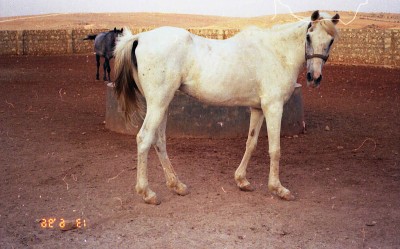Photo of the Day: desert-bred Kuhaylah Trayfiyyah from Syria
This very old mare is a Kuhaylah Trayfiyyah from the Middle Euphrates valley in Syria, near the small town of al-Mayadin.
This area general is home to the tribe of al-Aqaydat (Ageydat), a wealthy and powerful semi-nomadic tribe of cultivators and small herders whose Shaykhs obtained a number of really good desert-bred mares in the first part of the twentieth century, sometimes through ghazu (raids) and sometimes through purchase and gifts. They bred these mares well, and protected them by using only asil stallions, and hence came to own reputalbe marabet. Today some of the prettiest and typiest Syrian horses came from these Ageyday marabet.
One of the most well known Aqaydat marabet is that of Kuhaylat al-Trayfiyyah, which is an old strain the history of which I don’t know well. All I know is that it might – just might – derive its name from Matarifah clan of the ‘Anazah tribe. The strain is mentioned in the Abbas Pasha Manuscript, in connection with events that took place in Eastern Arabia, either in Bahrain, Qatar or the al-Ihsaa region of Saudi Arabia.
The Kuhaylah Trayfiyyah is the photo was not registered in the WAHO Syrian Studbook and I don’t know the reason. Perhaps some of her papers or authentication documents were missing or incomplete, perhaps she did not meet the Registration Committee’s criteria, and perhaps her owners did not want to register her, which was not uncommon at the time.
I recall being struck by her high withers, her deep girth, her sloped shoulder, her short-back, her level croup, her beautiful pricked ears, and her overall graceful and gentle appearance, despite her old age, and poor condition. Photo taken at Radwan Shabariq’s farm near Aleppo, in 1996, where this mare was being brought to be bred by his Hamdani ibn Ghurab stallion al-Aawar.

Just browsing through. I am very interested in the history of horses, so I will be back
Nice article; 1st time I read in English about horse in Al-Ahsa region of Saudi Arabia; me being a member of one of 1st Anizah tribe to reside in Al Ahsa around 450 years ago. The only history I know about my forefather’s horses is one which is told by the elderly in social gatherings. Most vivid ones are of horses and breeders that lived around the time frame of Al Ahsa treaty between Kind Abdul-Aziz Al Saud and Sheikh Mohammad Al Shayeb Al Arfaj Al Anizi who signed the treaty representing Al Ahsa people. thx once more i hope i can learn more about this topic.
Yasser, thanks for visiting. You need to record on audiotape these stories while the elders are still alive. Your culture is grand, but it is oral, and hence fragile. We have started doing that among the Shammar in Syria. If you have a chance to do so, then please write back these stories on this blog
You alo need to read Hamad al-Jasir’s book about horses in Arabia, and Muhammad al-Hajiri’s book on the same topic. Both are in Arabic.
alsha
I know now why she was never registered. She came from Iraq.
I know now why she was never registered in the Syrian studbook. She came from Iraq.